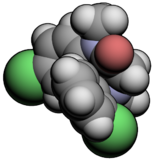 | |
 | |
| Clinical data | |
|---|---|
| Trade names | Melex, Sedoxil |
| Other names | 13-chloro- 2-(2-chlorophenyl)- 5-methyl- 3-oxa- 6,9-diazatricyclo[8.4.0.02,6] tetradeca- 1(10),11,13-trien- 8-one |
| AHFS/Drugs.com | International Drug Names |
| Routes of administration | Oral |
| ATC code | |
| Legal status | |
| Legal status |
|
| Pharmacokinetic data | |
| Metabolism | Liver (CYP3A4) |
| Excretion | Kidney |
| Identifiers | |
| |
| CAS Number | |
| PubChem CID | |
| ChemSpider | |
| UNII | |
| KEGG | |
| CompTox Dashboard (EPA) | |
| Chemical and physical data | |
| Formula | C18H16Cl2N2O2 |
| Molar mass | 363.24 g·mol−1 |
| 3D model (JSmol) | |
| |
| |
| (verify) | |
Mexazolam[1] (marketed under the trade names Melex and Sedoxil)[2] is a drug which is a benzodiazepine derivative.[3] Mexazolam has been trialed for anxiety and was found to be effective in alleviating anxiety at one week follow-up. Mexazolam is metabolised via the CYP3A4 pathway. HMG-CoA reductase inhibitors including simvastatin, simvastatin acid, lovastatin, fluvastatin, atorvastatin and cerivastatin inhibit the metabolism of mexazolam,[4] but not the HMG-CoA reductase inhibitor pravastatin.[5][6] Its principal active metabolites are chlorodesmethyldiazepam (also known as chloronordiazepam or delorazepam, trade name Dadumir) and chloroxazepam (also known as lorazepam, trade name Ativan).[7]
- ^ DE Patent 1954065
- ^ "Benzodiazepine Names". non-benzodiazepines.org.uk. Archived from the original on 2008-12-08. Retrieved 2009-04-05.
- ^ Kurono Y, Kamiya K, Kuwayama T, Jinno Y, Yashiro T, Ikeda K (September 1987). "Kinetics and mechanism of the acid-base equilibrium of mexazolam and comparison with those of other commercial benzodiazepinooxazole drugs". Chemical & Pharmaceutical Bulletin. 35 (9): 3831–3837. doi:10.1248/cpb.35.3831. PMID 2893667.
- ^ Mc Donnell CG, Harte S, O'Driscoll J, O'Loughlin C, Van Pelt FN, Shorten GD (September 2003). "The effects of concurrent atorvastatin therapy on the pharmacokinetics of intravenous midazolam". Anaesthesia. 58 (9): 899–904. doi:10.1046/j.1365-2044.2003.03339.x. PMID 12911366. S2CID 25382546.
- ^ Ishigami M, Takasaki W, Ikeda T, Komai T, Ito K, Sugiyama Y (August 2002). "Sex difference in inhibition of in vitro mexazolam metabolism by various 3-hydroxy-3-methylglutaryl-coenzyme a reductase inhibitors in rat liver microsomes". Drug Metabolism and Disposition. 30 (8): 904–910. doi:10.1124/dmd.30.8.904. PMID 12124308. S2CID 2620104.
- ^ Ishigami M, Honda T, Takasaki W, Ikeda T, Komai T, Ito K, Sugiyama Y (March 2001). "A comparison of the effects of 3-hydroxy-3-methylglutaryl-coenzyme a (HMG-CoA) reductase inhibitors on the CYP3A4-dependent oxidation of mexazolam in vitro". Drug Metabolism and Disposition. 29 (3): 282–288. PMID 11181496.
- ^ Fernandes H, Moreira R (June 2014). "Mexazolam: clinical efficacy and tolerability in the treatment of anxiety". Neurology and Therapy. 3 (1): 1–14. doi:10.1007/s40120-014-0016-7. PMC 4381915. PMID 26000220.